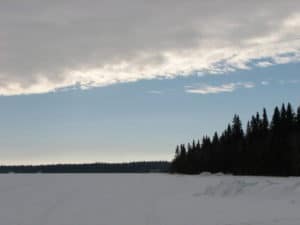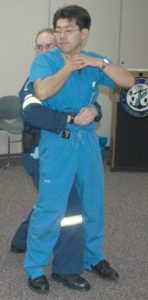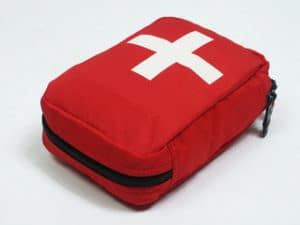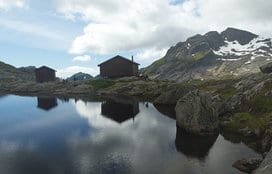
The Rule of 3 is a crucial, even foundational, bit of wilderness survival wisdom. There are many various pieces of wisdom out there when it comes to survival and not all of them are created equal. While modern society makes living easy, being able to survive in an emergency situation or wilderness survival situation is a chore.
Even many educated & skilled individuals don’t make it when the rubber hits the road.
If you don’t have a solid wilderness survival education, your chances of getting through an emergency plummets. People don’t just survive by accident. If you’re an old hand at survival, you already know the Rule of 3 in wilderness survival. If you’re a true beginner, then the Rule of 3 is the foundation for survival that you will want to build around.
The Rule of 3 is a great quick reference that can help people understand their priorities when in an emergency situation, focus in on what needs to be done, and fall back to that to fight off confusion or fear.
Read on to learn more.
 The Survival Rule Of Three
The Survival Rule Of Three
Whenever you learn anything, it’s important to get the basics. There are simply certain pieces of information or learning that become the foundation to everything else. The Survival of Three is one of those base pieces of information.
While at first glance it might seem like a cute oversimplification, this remains useful no matter how experienced you are. In fact, conditioning your mind in wilderness situations to jump back to this rule when confused or stressed is a great way to prepare yourself to react well in any emergency situation.
The Rule of Three was something that I learned a long time ago, all the way back during the Cub Scout days. Dad was a Scoutmaster, in addition to a lifelong hunter, angler, and something of a prepper. Growing up meant spending time outside all the time, camping all the time, and at a time where helicopter parenting wasn’t a thing.
So even back then, I was learning what to do if I got lost. What was most important, what not to worry about until later. The older I got, the more information was added to that. Summed up into the Rule of 3 that just became thicker and continued to grow over time.
As I grew older the adventurous streak definitely woke up and this rule became even more important whether I was exploring Alaska, jumping into spur of the moment road trips, or exploring New England and the upper areas of the Appalachian Trail.
During all that time the wilderness survival rule of 3 stayed an important part of my outdoor education and it has continued to expand. Read on to learn about it in depth so you’ll be more prepared for any future emergency!
Explaining Survival’s The Rule Of Three
Basically the heart of the Rule of Three is about the needs of the human body when it comes to surviving. Generally the order is Air, Shelter, Water, & Food. There is a three that applies to each of those but the three is quite different. For example for air the three represents minutes. For food it represents three weeks.
First let’s introduce the original framework for “The Rule of Three,” to get down the basic survival foundations. After that we’ll expand to the other options, addendum, and alternatives that have been added to this basic framework over time.
The original Rule of Three for Survival
- The average person can live for 3 minutes without breathable air
- The average person has up to 3 hours to find shelter in harsh weather
- A person in non-harsh environments can go up to 3 days without water
- Most people can live up to 3 weeks with no new food
This is a great baseline or rule of thumb, but it is important to recognize that these aren’t 100% hard and fast. Someone with more body fat might be able to go more than 3 weeks without food while someone really used to an extreme environment might get an extra hour before being in trouble.
However, in general these are great beginning rules of thumbs. You’ll also notice that each one builds off of the others.

As long as you are breathing without issue (and without an immediate emergency situation of another kind like icy hypothermic water or a gashing leg wound) you then have 3 hours to find or create outstanding shelter in a harsh environment. Harsh environment can refer to passing weather like a sleet storm or a more permanent harsh climate like Arctic Tundra or desert.
Assuming you can take care of having solid shelter then you have three days to worry about finding a solid water supply. As long as you can get consistent water to keep you going then you likely have 3 weeks or more to find food.
Air – Shelter – Water – Food
That’s the order of importance to stay alive. Obviously without air death comes very quickly. Unconsciousness can even happen well before the 3 minutes depending on the situation, making that even more critical.
Shelter is all about a HUGE factor in survival: core body temperature.
If you get too cold, you die. If you get too hot, you die. This is often referred to as core body temperature but it ties in directly to having stable shelter.
Pretty much everyone knows the importance of drinkable water. Three days is a general rule of thumb but it can be a lot less in especially hot or harsh climates, or if you’re forced into a lot of exertion. Three days is far shorter a time than three weeks, which does a great job of showing just how big a difference there is in importance between water and food.
The original survival Rules of Three still hold up.

Alternatives to Survival’s Rule of Three
Whether you would call these alternatives, additions, or supplements, I’ve read many different pieces of information that added other things to the original Rules of Three. Some of these came from online survival pages, some from prepper blogs, and some from written material.
This is why the Rule of 3 is good as a foundation. Because it gives crucial information that can then be built upon.
So what else is included in the “Revised Rule of Three?”
The most common two I see address some very common emergency situations in wilderness survival or accident situations.
Along with “3 Minutes without breathable air” add severe bleeding and icy water to the 3 minute list. If you have an injury that is causing severe bleeding, that needs to be addressed immediately. The same is true with being exposed to icy water. Wet clothes from icy water means you need a fire to warm up fast (and you need to get out of those clothes) or you won’t live long enough to worry about water.
Less traditional as an add-on, but one I’ve seen as well, is 3 months without hope. I’m not sure there’s a scientific way to measure this, but hope does matter. Not as much as breathing, shelter, water, and food, but over and over again amazing survival stories have some common factors with a major one being the refusal to die. Determination to survive. In other words, unshakable hope.
So measurable or not – there might be something to this.
That would change the full revised Rule of Three to:
- 3 minutes max before needing breathable air, to treat severe bleeding, to get out of icy water (and treat hypothermia)
- 3 hours before you must find stable shelter from extreme weather/environments
- 3 days before needing water
- 3 weeks before needing food
- 3 months before losing hope
Dealing With Air/Bleeding/Icy Water Issues
Some situations have to be dealt with immediately because they can be very fast killers. Breathing is self-explanatory. If you can’t breathe, you die. If you are gushing out blood from an open wound and don’t close it, you’ll die very quickly. If you’re soaked in icy water your body temperature will plummet, your heart will stop, and you’ll die.
See a pattern forming?
There are certain problems that need to be dealt with immediately in any emergency survival situation. They must take precedence over everything else!
Keep in mind that 3 minutes is a general rule, but it isn’t gospel. If someone is choking they often go unconscious well before three minutes. Someone with true “Norse blood” and who is really aligned with the cold might be able to last 5 minutes instead of three. But that being said, the point is 3 minutes isn’t much time at all.
If you find yourself with one of these issues then you need to fix it immediately.
This also means being prepared for worst case scenarios.

Breathing Aid Preparation
Obviously not being able to breathe is a serious worst case scenario. There are a few things you can still do to prepare for the most likely situations you would run into where this would become an issue.
The first is knowing the Heimlich maneuver and ideally encouraging close friends, co-workers, family, and people you spend a lot of time with to also learn. Since emergency situations can happen at any time you need to learn the Self-Heimlich. This gives you a strong chance of being able to clear your own air pipe if choking.
If choking isn’t the main issue then you’re looking at the four A’s for oxygen: Asphyxiation, Asthma attack, Allergic reaction, or extreme Altitude.
Asphyxiation
Whether stuck in a building where oxygen is leaking out, in a cave where gasses are building up, or any area where something is squeezing out the breathable air, you need to be able to recognize the early signs of losing oxygen to give yourself as much time as possible to figure out the problem, or head immediately to a solution.
This is a relatively rare issue, but it can happen and understanding the early signs at least gives you a chance to start the timer in your head and make an immediate move to an area (often outside) where there is going to be breathable air.
Asthma attacks
Outside of choking one of the most common breathing issues is asthma. Asthma attacks are going to vary based on severity and situation, and it is up to the individual to have their inhaler on them in addition to being able to stay calm, focus on breathing, and do what they can to improve their situation.
There might only be so much to do without an inhaler out in the wild, but whatever actions can be taken to improve breathing need to be taken. As long as you’re still breathing, you still have a chance to fight.

Allergies (specifically allergic reactions)
A life threatening allergy could be a huge reason that breathing becomes an issue in an emergency or survival situation. These can come from insect stings, contact with a plant, or eating a type of food you’re allergic to. This is a major one to look at.
Some of this takes common sense. If you’re allergic to nuts, even in a wilderness survival situation don’t eat anything that looks like a nut. Look for other sources with food. Ditto with things like seafood or not knowing if that fish is poisonous to eat or not.
One of the most common ones are bee stings. In fact, this is the type of allergy that would worry me the most if I was out in the wild since I’m also allergic. For people deathly allergic there is never an excuse to go out without an EpiPen.
Even if you’re not “that” allergic, what happens with multiple bee stings or a badly placed one? A bee sting doesn’t cause breathing issues with me normally, but it does cause massive swelling. So what would happen if 2-3 bees stung me in the neck or upper chest? That could easily lead directly to breathing issues.
In my case Benadryl is the best non-prescription medication for dealing with allergic reactions form bee stings. Two tablets is enough. I carry six. Never having suffered multiple stings or having to cut out stingers in the wild, better to be over-prepared than not at all.
In time the body will heal – so the goal here isn’t perfect treatment in a survival situation but just doing enough to stay breathing. As the old family motto goes: “So long as one breathes, there is hope.”
Extreme altitude
Breathing at extreme altitude is difficult. However as dangerous as that can be, the body does adjust. Make sure to move slowly. While even 1,000 feet lower can make things much easier on the body, you don’t want to go too fast. Make a nice steady progress. Rest as often as needed. Conserve your energy and breath, but make that slow move downward.
Altitude makes a huge difference so move on down over time to get to lower altitudes where breathing is easier.
Training Summary:
- Learn the self-Heimlich maneuver
- Make sure that your learn how to recognize all the early signs of asphyxiation
- Allergy sufferers need to ALWAYS carry helpful medications
- Learn about altitude and its effect on the human body
- Be prepared for any potential disaster
 Bleeding First Aid Preparation
Bleeding First Aid Preparation
Severe bleeding definitely belongs in the “three minute” category. People are often surprised by just how much bleeding can come from a serious injury or wound. While three minutes is a rule of thumb for how long you can go before bleeding out and dying, many people pass out in half that time.
The body can recreate blood over time but the injury needs to be stopped right away. Bleeding first aid is generally the same. Get a thick bit of cloth and press firmly, putting as much pressure as possible to close the wound. Putting a constricting band above the wound if it’s on a limb, and raising the limb above heart level, are ideal if the situation allows.
While difficult to do with one hand, if you have a firm cloth pushed against the blood to staunch the bleeding, wrap over the top of it with a firm cloth bandage to keep it into place. Don’t do it loosely – you want this really, really tight. Stopping blood loss is the primary goal here.
While not ideal, duct tape can be a great way to cinch up a bleeding injury, especially when wrapped around. This could lead to some long-term issues and nasty scarring – but if it’s either that or bleed out and die, go with the duct tape to stop the bleeding.
Bleeding first aid is crucial to be prepared for these scenarios.
In review:
- Learn basic first aid for bleeding and wounds
- Carry a first aid kit or cloth bandages wherever you go
- Practice wrapping yourself up as if injured – including one arm to wrap an injured arm

Icy Water Preparation
Hypothermia can be a fast killer even in moderately wet or uncomfortable conditions. However if you find yourself in icy water three minutes is an absolute best case scenario before you seize up and die. Many people will succumb earlier than that.
Being in icy water is the quickest way to obliterate your core body temperature and give you a heart attack. Water saps heat from the body far quicker than air. You’re better off naked in a blizzard than bundled up in an icy river.
Getting out of icy water needs to be the immediate priority if that’s where you find yourself. Even in winter or cold, once out of water you need to strip wet clothes off. You’re better off with bare skin than wet clothes. Then you need to warm up.
If you’re incredibly lucky with a potential indoor shelter right there, run for it! On the other hand if you’re out in the wild, you need to spend the precious minutes/seconds before shivering gets uncontrollable to get a fire going. Even a small amount of heat in the cold makes a huge difference.
Obviously the ideal situation is a roaring fire in a shelter, but one step at a time. You have 3 hours in a harsh environment without shelter if you’re out of icy water and can get a fire going. Warm up, dry out clothes, survive.
So to prepare:
- Always have a good fire starter on you (like fire steel) in addition to matches/lighter
- Train in conditions where you can bail safely (this video gives a basic idea of how to do so)
- Keep your head about you, keep focused on keeping the blood moving
- Get out of the icy water

Dealing With Shelter Issues
You get three hours (roughly) in a harsh environment without shelter. Once again this is a rule of thumb. It if is 130 degrees and you’re in the sun without water, it might be less. If it’s 50 degrees below zero you may have less. The point is that the most extreme of environments can be devastating on the human body and that means you need to be prepared to find shelter fast or make one that’s good enough to buy more time.
The good news is that a good shelter from the environment doesn’t just buy you hours but it buys you days. Weeks if you can find water. That’s why taking care of this need is important.
The definition of a good shelter varies depending on the situation. In an Arctic scenario a cabin is ideal, but barring that a shelter that traps your body heat in an area and gives room for a fire is a great runner up. That ability to be out of the wind, out of the snow, and to make one small area warm so you’re out from the cold.
On the other side of things, in a sweltering area shade becomes a huge priority and ground that isn’t burning. Yet if you’re in a desert, chances are you’ll be cold at night…so there is a lot to take into consideration.
The immediate goal is getting shelter. Not perfect shelter, not great shelter, just the best shelter you can get to quickly that does the job. Once you have a bit more stability you have the ability to make that shelter better over time or find a better place to setup, but the first step is getting out of the environmental killers.
Why does the environment matter? Because the CDC numbers in this Washington Post article shows the number of people killed by both heat and cold exposure over the years.
Core Temperature Is Your Main Focus
One of the biggest factors in any survival situation is core body temperature. Dying from sun stroke or heat exhaustion takes place because your core body temperature gets too high. Dying from hypothermia happens because your core body temperature gets too low to survive.
The point of shelter is making absolutely sure that your core body temperature stays in a safe range so you’re not only alive but so you can actually function at a level that allows you to contribute to your own survival.
Often being able to make a fire goes hand in hand with appropriate shelter. Whether in fall or winter conditions, coming out of water in potentially hypothermic conditions, or even the desert at night, there are many times you’ll want a fire. Practicing multiple ways of starting a fire in multiple conditions will help you to be prepared for many of these scenarios when they really become a life or death matter.
If you haven’t practiced these skills before consider looking for a local primitive skills club or a guided wilderness survival camp to help you challenge and hone yourself among individuals who can guide and support you along the way.
In summary:
- Practice perfecting those fire starting/making skills
- Always carry fire starters and some type of tinder (Q tips, cotton balls, etc)
- Train up in overnight wilderness survival camps or classes
- Train and prepare yourself for any potential survival scenario you can imagine yourself in because you just never know

Dealing With Water Issues
Water is extremely important when it comes to survival situations, and almost everyone with even the most basic of survival or woodlands knowledge knows just how much more important than food it is. That’s why the rule is 3 days for water and 3 weeks for food.
Understanding the 3 day “rule” for water and the 3 week “rule” for food was the first way Jon and I were introduced to survival’s Rule of Three. This was something that was taught very early in Scouts. Even back then the stark contrast between the two made it easy to remember the difference and understand the need for priority if I was ever lost in the woods.
So how do you deal with the water issue when so much water even in the wild isn’t going to be safe to drink thanks to pollution or other issues (look up “Beaver Fever” for an unpleasant view on issues even truly in the wild water sources can hold)?
There are actually several options available to help tackle this conundrum.
While there are some truly dry areas, unless you are fireless in the Arctic or stuck in the desert, chances are there’s some water somewhere. It just might not be safe without treatment.
Those last two words are the key! An easy solution is to carry water purification tablets wherever you go. These make it easy to take out most of the issues any contaminated water can have. If you have time, shelter, and the ability to make a fire, boiling takes care of just about everything, as well.
A device most thru hikers and wild backpackers take now is the “Lifestraw.” This makes it easy to drink directly from a water source knowing everything or virtually everything will be filtered out leaving behind water you can drink with confidence.
This is a lightweight product that you should be able to carry around everywhere.
However if there seem to be no solid options, in a life or death situation you’re better off drinking contaminated water and taking your chances with getting sick later than dying of thirst right then and there. Buying yourself time is the most important thing in those extreme scenarios.
So remember: three days or less for water!
So in summary:
- Study an area ahead of time to learn were local water sources are (hiking maps are especially great for this)
- Always carry a Lifestraw and/or water purification tablets
- If in a life or death situation, drink the water and buy yourself time

Dealing With Food Issues
While food doesn’t compare as a survival issue to breathing, bleeding, icy water, shelter, and water, the longer you’re out in the wild the more it is going to end up mattering. While you can go three weeks roughly without food, the energy levels are going to suffer and even a little bit here and there can make a world of difference.
Preparation wise that means making sure any survival kit has at least a little bit of a calorie dense food. You would be amazed how long you could live from the calories of one jar of peanut butter. Beyond preparation, understanding that after taking care of the rest, getting food will help you keep up your energy and keep up hope. Both things are essential to surviving in a really tough situation.
Ahead of time you should study an area to get to know native plant life and see if there are obvious plants, edible weeds, or nuts or berries that might be found in abundance. Having a little bit of fishing line or hooks to help potentially catch some food in the wild is also a good sign of being prepared.
Knowledge here is your friend. Knowing what common weeds, flowers, and berries are edible and which are not matters a lot. Catch insects (watch the legs of grasshoppers or crickets), dig up worms, look for acorns to break open, fry up snails. There are ways to find food and nutrients, but always go on the side of caution.
You can go three weeks (or if you have some extra body fat, longer) without food. Getting even a few calories here and there can extend that period for quite a bit. Plan and act accordingly.
So in summary:
- Study wild food sources, especially in areas you’ll be outdoors
- Carry calorie dense “survival food.”
- Practice while weekend camping to get use to looking for and spotting wild food
- If in doubt, don’t take chances
In Conclusion
Survival is never easy even in the best of situations and if you find yourself in a survival situation, you’re probably not starting out in the best shape. While a little bit of knowledge, research, and following the old Boy Scout motto of “Be Prepared” you can help tilt the scales in your odds a little bit more.
Even with knowledge, there’s no promise it will be easy. Once again, refer to the opening sentence of this section. However, even if you’re not very knowledgeable or experienced in wilderness survival the Rule of Three can help you focus, act, and survive.
Practice these skills, memorize these rules, and use that as a foundation for learning more and getting better. You may never need these skills, but you never want to be in a situation where you do and don’t have them. There’s also a certain confidence that comes from knowing you can survive.
Start by always remembering the Rule of Three, prepare for any situation that can come up, and keep your head. You do this and follow this blueprint and your chances of making it through will go up dramatically. Practice hard so you can stay safe!
Rule of 3 Explained in Video
Resources, Further Reading, & Sources

